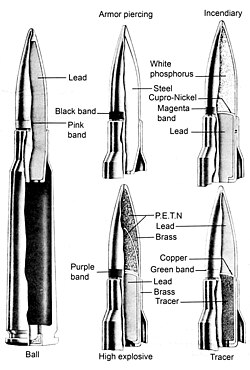| Type 99 7.7 mm rimless | ||||||||
|---|---|---|---|---|---|---|---|---|
 7.7×58mm Arisaka | ||||||||
| Type | Rifle | |||||||
| Place of origin |
| |||||||
| Production history | ||||||||
| Produced | 1939–1945 | |||||||
| Variants | Type 92 semi-rimmed 7.7 mm, Navy type 7.7 mm | |||||||
| Specifications | ||||||||
| Bullet diameter | 7.89 mm (0.311 in) | |||||||
| Neck diameter | 8.07 mm (0.318 in) | |||||||
| Shoulder diameter | 11 mm (0.43 in) | |||||||
| Base diameter | 12 mm (0.47 in) | |||||||
| Rim diameter | 12 mm (0.47 in) | |||||||
| Rim thickness | 1.0 mm (0.039 in) | |||||||
| Case length | 58 mm (2.3 in) | |||||||
| Overall length | 79.5 mm (3.13 in) | |||||||
| Primer type | Large Rifle | |||||||
Ballistic performance
| ||||||||
| Type 92 semi-rimmed 7.7 mm | ||||||||
|---|---|---|---|---|---|---|---|---|
 Various Type 92 rounds | ||||||||
| Type | Machine gun round | |||||||
| Place of origin | Japan | |||||||
| Service history | ||||||||
| Used by | Japan | |||||||
| Wars | Second World War | |||||||
| Production history | ||||||||
| Variants | Type 99 rimless 7.7 mm (Arisaka), Navy type 7.7 mm | |||||||
| Specifications | ||||||||
| Case length | 2.25 in (57 mm) | |||||||
| Overall length | 3.14 in (80 mm) | |||||||
Ballistic performance
| ||||||||
| Test barrel length: 29.5 inches | ||||||||
The 7.7×58mm Arisaka cartridge or Type 99 rimless 7.7 mm was chambered in the World War II Arisaka Type 99 Rifle. The cartridge was designed to replace the aging 6.5×50mm Arisaka cartridge after seeing the 8×57 IS in action in China during 1937. Due to lack of materials the plan to phase out the 6.5 mm Arisaka cartridge by the end of the war was not completed.
While the round chambered by the Arisaka rifle used a rimless case, rimmed and semi-rimmed variants were produced for use in some Japanese machine guns. This machine gun ammunition is more powerful, and the altered rim is meant to prevent it from being chambered in a rifle. The 7.7 mm Arisaka uses the same .311–.312" bullets as the .303 British,[1] and its cartridge case is similar in power to the .30-06 Springfield (7.62×63mm). Factory loaded ammunition and brass cases are available from Norma and Graf; Hornady, Sierra and Speer also produce usable bullets. Reloadable cartridge cases can be produced by reforming .30-06 brass, or fire forming 7.92×57mm cases. Case heads derived from the .30-06 will be slightly undersized and will bulge slightly just ahead of the web on firing, while the 7.92×57mm derived cases will be slightly short. Normal cases of the correct dimensions will also bulge slightly, however, as most Japanese rifles of this era had slightly oversized chambers, intended to allow the bolt to be closed on a round even in a very dirty chamber. Reloading data for .303 British is a good starting point for load development, since the two cartridges are nearly identical.
The 7.7×58mm Arisaka as a sporting cartridge is suitable for most big game with proper bullet selection.
7.7×58mm Type 92[]
The Type 92 (Semi-rimmed) 7.7 mm (7.7×58mm SR) was a machine gun cartridge and was primarily used with the Type 92 Heavy Machine Gun and the earlier Type 89 flexible and fixed air-cooled machine guns used on Japanese planes.
Japanese ammunition[]
All Japanese ammunition used gilding metal jackets for the bullets on ball and the PETN-filled flat-tipped explosive incendiary, cupro-nickel jackets for tracer and phosphorus incendiary and a brass bullet with steel core for armor-piercing.
- Ball—lead core
- Tracer—lead core
- A.P.—hard steel core
- Incendiary—White phosphorus and lead
- H.E.—PETN and lead
Late war ammunition can still be encountered, although it is generally advisable not to fire it, due to its collectability and the possibility of a hangfire or squib.
Gallery[]
See also[]
- List of rifle cartridges
- 7 mm caliber—Other 7mm cartridges
References[]
- TM 9-1985-4, Japanese Explosive Ordnance
- "The 7.7×58 Japanese Arisaka (7.7 mm Jap)" by Chuck Hawks
- "7.7 mm Japanese or 7.7×58mm Japanese Arisaka"
- "The 7.7 Arisaka" by Bob Forker for Guns & Ammo
- Japanese Ammunition 1880–1945 Part 1; Rifle, pistol and machine-gun ammunition up to 20mm by Ken Elks (2007)
- Modern Reloading Second Edition by Richard Lee (2003), page 487
| ||||||||||||||||||||||||||||||||||||||||||||||||||||||||
The original article can be found at 7.7×58mm Arisaka and the edit history here.
